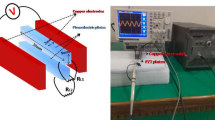Abstract
The non-contact excitation of multiple piezoelectric components (PZT) through bidirectional electric field transmission system has been explored. In the proposed technique, two parallel plate capacitor-like structures have been designed with a pair of ground copper electrodes along with a live copper electrode, and two PZT plates are equidistantly placed in between each live and ground electrode. Experimentally, it has been observed that piezoelectric plates are wirelessly energised as a result of both electric and piezoelectric resonances. Maximum vibrational displacement can be obtained over the piezoelectric plates at a point, when the operating frequency of the E-field generator matches with the frequency of the mechanical resonance of the PZT plate. The maximum output power (\(P_{\mathrm{out}})\) across the non-contact stimulated piezoelectric plates principally depends on resonance, resistive load, vibration mode, driving frequency, position of PZT component etc. The output power obtained across the excited piezoelectric device by bidirectional non-contact energy transfer has been appreciably higher than that of the single PZT component excited by simple parallel-plate capacitor structure. The maximum output power of 0.271 mW and 0.298 mW are acquired across piezoelectric plates at a resonance frequency of 924 kHz and 350 \(\Omega \) optimal loads with 50 V input, when the live and ground electrodes are separated by 4 mm. By enacting the proposed wireless excitation technique, multiple piezoelectric devices can be energised together.













Similar content being viewed by others
References
S Ozeri and D Shmilovitz, Ultrasonics 50, 556 (2010)
A A Zakharenko, Pramana – J. Phys. 79, 275 (2012)
K R M Rao, P H Rao and B S K Chaitanya, Pramana – J. Phys. 68, 481 (2007)
K Vollmers, D R Frutiger, B E Kratochvil and B J Nelson, Appl. Phys. Lett. 92, 4103 (2008)
F Lucklum and B Jakoby, Sens. Actuator A: Phys. 145, 44 (2008)
A Bayrashev, W P Robbins and B Ziaie, Sens. Actuator. A: Phys. 114, 244 (2004).
B Watson, J Friend and L Yeo, Sens. Actuator. A: Phys. 152, 219 (2009)
D Caratelli, A L Ekuakille and P Vergallo, Prog. Electromagn. Res. 135, 91 (2013)
J D Boeij, E Lomonova, J L Duarte and A J A Vandenput, Sens. Actuator. A: Phys. 148, 319 (2008)
D Caratelli, A Yarovoy, A Massaro and A Lay-Ekuakill, Prog. Electromagn. Res. 125, 391 (2012)
W T Coakley, D W Bardsley and M A Grundly, J. Chern. Technol. Biotechnol. 44, 43 (1989)
P P Nayak, D P Kar, S K Samal, A Mohanty and S Bhuyan, Int. J. Electron. Commun. 78, 1 (2017)
S Bhuyan and J Hu, Appl. Phys. Lett. 91, 264101 (2007)
Takuro Ikeda, Fundamentals of piezoelectricity (Oxford University Press, 1990)
Author information
Authors and Affiliations
Corresponding author
Rights and permissions
About this article
Cite this article
Nayak, T., Patnaik, D., Swain, B.R. et al. Non-contact excitation of piezoelectric components through bidirectional energy transfer system. Pramana - J Phys 94, 74 (2020). https://doi.org/10.1007/s12043-020-1929-6
Received:
Revised:
Accepted:
Published:
DOI: https://doi.org/10.1007/s12043-020-1929-6




